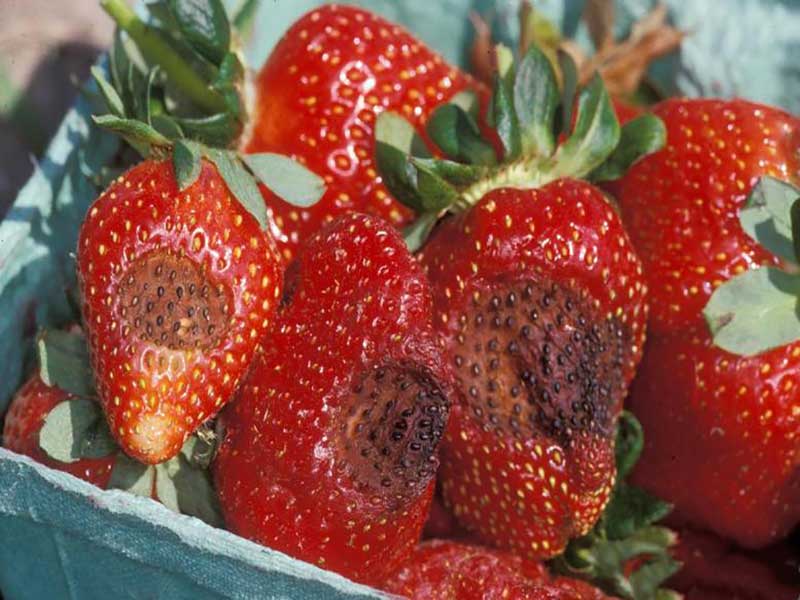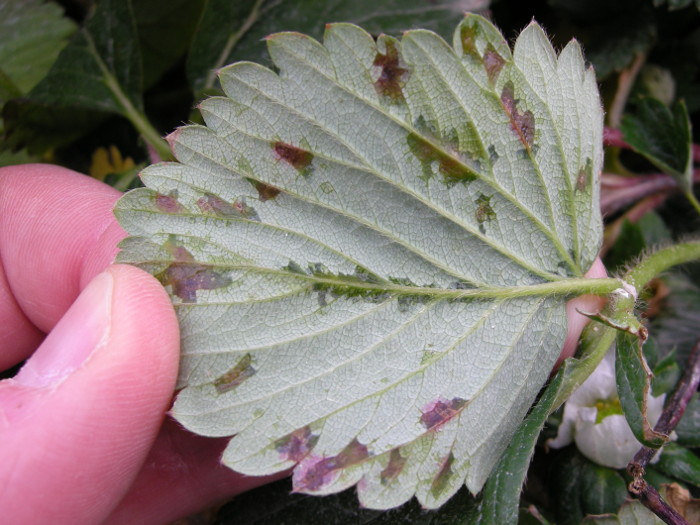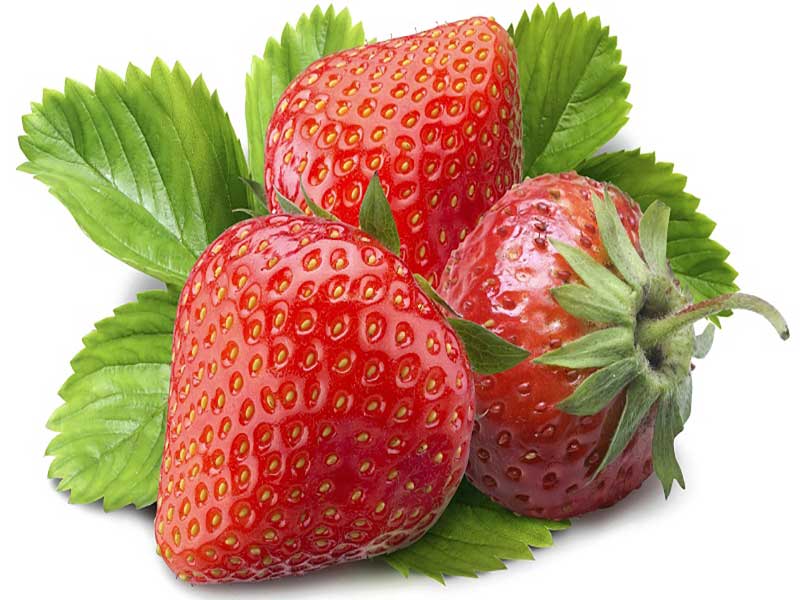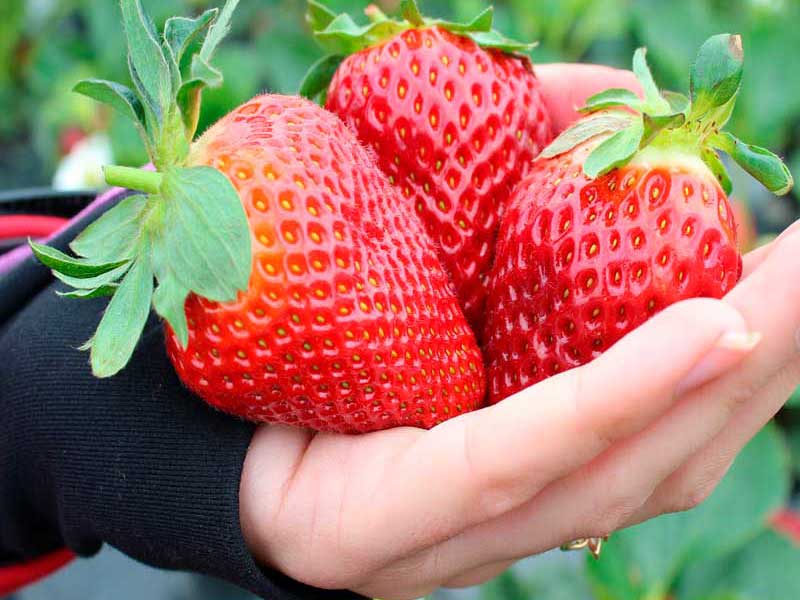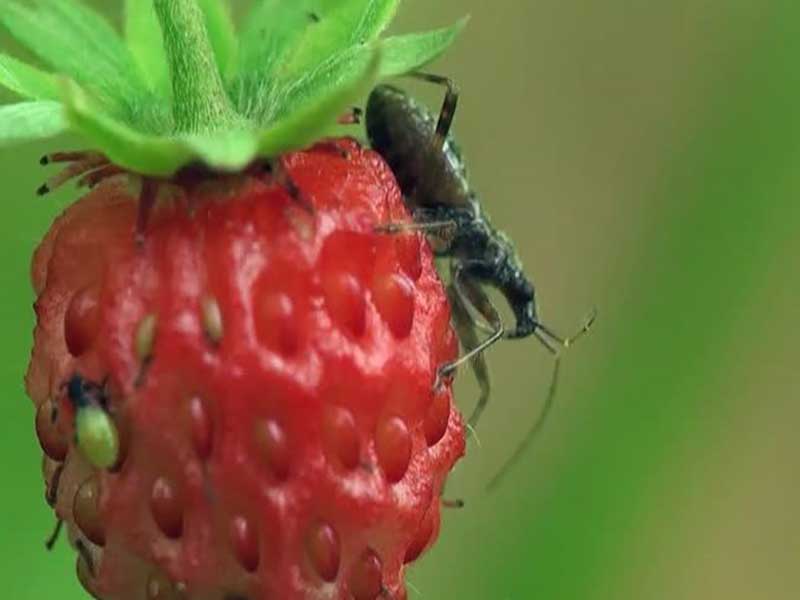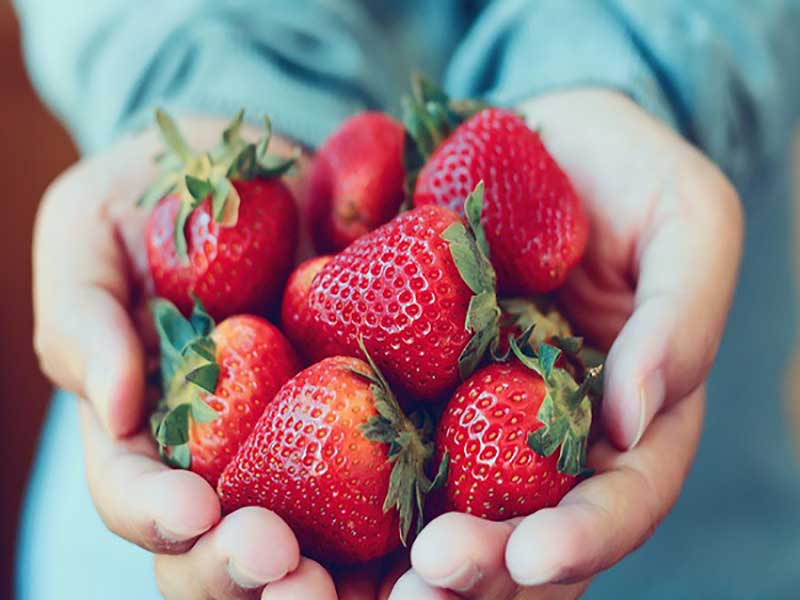Types of strawberry diseases and how to manage them Chapter 3
The purpose of this paper is to provide information about how to plant, harvest and harvest strawberries. In this chapter, we will familiarize you with the types of strawberry diseases that we have fully described and then we have mentioned ways to manage these diseases. Chapter 3
Types of strawberry diseases and their management and control
A) Fungal diseases of strawberries
Powdered whites of strawberries
Cause of disease: Sphaerotheca macularis
This disease reduces plant growth, crop yield and fruit quality. The cause of the disease is all the aerial organs such as the leaves of the flower and the fruit, which in the case of fruit and flowering is severe damage. The appropriate temperature is the spread of disease 16 to 27 degrees Celsius and in conditions of high relative humidity, even in dry soils, the activity of the disease agent is high.
Management:
- Collecting and removing the remains of the aloudeh of winter.
- Use of resistant cultivars
- Creating a co-oriental light
- Biological control using ampelomyces Quisqualis noun AQ10
- Spraying benimeyl or kapitan beaks at fruiting time
Strawberry Leaf Burn
Disease Agent:Diplocarpon earlianum
The disease is severe in hot weather.Wet leaf surface for more than 12 hours and temperatures of 27 to 30 degrees Celsius makes the field susceptible to disease. Stains appear 6 to 15 days after diffusion.
Management:
- Using resistant authorities
- Collecting plant residues of aludeh
- Ventilated and adequate lighting
- Using healthy transplants
- Weed control
- Chemical control of appropriate basmum such as methyl thiophaneate

Leaf burns and rotting of strawberry fruit
Cause of disease: Phomopsis obsurans
One of the most important diseases of aerial parts is the initial spots on the spherical leaf spread and the red fringe is the spots next to the v-shaped veins, the wide part of which is towards the edge of the leaf.Pink spots of the adipose color appear on the fruit that gradually becomes large and brown dark brown in the center of the light brown fringe.
Management:
- Use of disease-free transplants
- Planting in the country with suitable drainage and ventilation
- Elimination of weeds
- Using Captain Yaprodion fungicides
Normal leaf spot
Cause of disease:Mycosphaerella fragariae
The symptoms are formed in the form of small spherical spots in purple to red in the upper level of the leaves. The central area of the stains gradually turns gray to black, while the sides remain pink. If the humidity and temperature are high, yellow spots are made without margins. The highest percentage of contamination was 27-33 °C and the leaf area was wet for 4-6 hours.
Management:
- Creating favorable conditions in the gallery including proper lighting and good ventilation
- Resistant cultivars
- Observing agronomic hygiene
- Using suitable prizes such as chlorine and talonyl at the early growth and repetition of spraying with a distance of 10 to 14 days
Entraconose
Disease Agent:Colletotrichum spp
The two most important diseases are crown rot and fruit rot. The initial spots appear as small, brown spots on the stalk and petiole. In some cases, contamination causes gaps in the area and if the petiole becomes infected, the whole plant becomes dry. The spots on the fruit are white and white, which change from light gray to brown after spreading. The contaminated fruits remain in a dry and omnivorous state hanging on the plant.
Management:
- Using healthy boots
- Use plastic malch between rows
– Collecting and removing contaminated fruits
- Chemical control using refachers from flower time to fruit harvesting with toxins such as captain
Mold or grey rot of strawberries
Disease Agent:Botrytis cinerea
It is one of the most important diseases, especially in hot and hot conditions. The cause of the disease infects flowers and fruits. Contamination begins at the end of the fruit and spreads to other parts. Plant tissue in infected area will be soft and watery. The fruit on the bush remains dry and mummified. The spread of the disease is at 20 to 30 °C and relative humidity is high. The study showed that the fruit was in flowering stage, but symptoms appeared during fruit formation.
Management:
- Observing the proper planting distance
- Precision in fertilization time and amount
- Covering between rows with mulch for no contact with the fruit
- Proper exposure and drainage
- Timely withdrawal.
- Collecting and destroying the al-Wadda bushes.
- Chemical control of proper basium such as captain and tyram
Leather rot
Disease Agent:Phytophthora cactorum
High humidity during harvesting causes 50% level of contamination. The fungus is the cause of soil disease that infects the fruit in the usual condition, but sometimes the contamination of flowers and crown rot has also been reported. The infected fruit is seen as dark brown or green with brown margins.
Management:
- Planting transplantation in the country with suitable drainage
- Using plastic mulch between rows and bushes
- Biological control by Serratia plymuthica before implantation
- Using ridomil or elite prizes
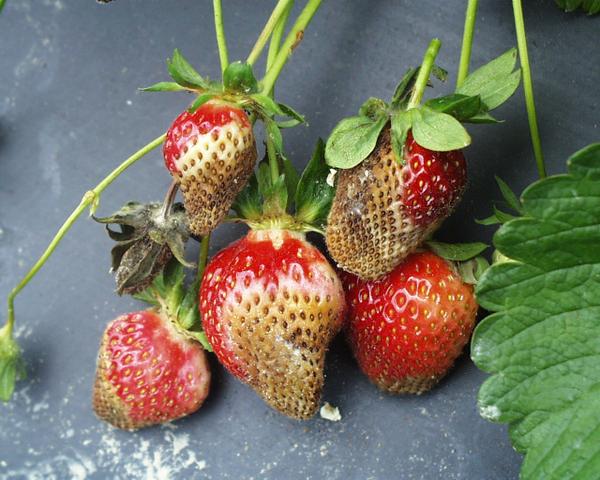
Watery rot of fruit
Disease Agent:Rhizopus stolonifer
Watery fruit rot is a postharvest disease during harvesting. Sprinkled and discolored spots are found on the fruit. The fruit is quickly softened. The cause of the disease enters the fruit through wounds.
Management:
- Rapid transfer of harvested fruit to cold storage
- Harvesting fruit early in the day
- Sanitary measures such as preventing fruit from getting wounded
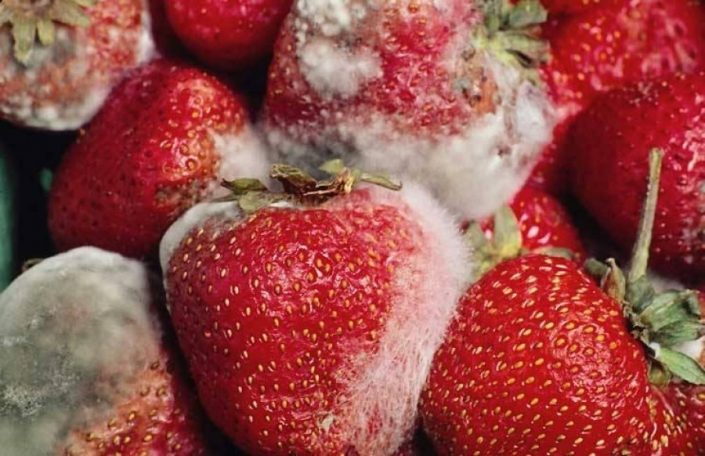
Vertiselium wilting
Disease Agent:Verticillium albo-atrum
One of the most important factors in limiting strawberry planting. The fungus causing the disease has a high durability in the soil and remains in the soil for up to 25 years. The first symptoms appear in newly implanted boots and at the time of production of the ingested stems. In infected plants, older and foreign leaves are dried, dried and darkened in the lips and between veins. Completely polluted bushes are dwarfs and produce small, yellow leaves. The optimum temperature for the fungus is 12 to 30 degrees, with an optimum temperature of 21 to 24 degrees.
Management:
- Planting in conditions with good light and drainage
- Resistant cultivars and healthy bushes
- Avoiding excessive use of nitrogen fertilizer.
- Soil disinfection before planting with chloropyrine33% and memethyl bromide 66%
Crown rot caused by phytotra
Disease Agent:Phytophthora spp
At first, the bushes and leaves shrink. The sudden wilting of infected bushes leads to the sudden death of the entire plant in a short period of time. In the transverse part of the infected area of the crown, brown lines of necrotic tissue can be seen. The highest amount of damage is seen in the flowering stage of the note.
Crown rot caused by phytotra
Cause of disease: Phytophthora spp
At first, the bushes and leaves shrink. The sudden wilting of infected bushes leads to the sudden death of the entire plant in a short period of time. In the transverse part of the infected area of the crown, brown lines of necrotic tissue can be seen. The highest amount of damage is seen in the flowering stage of the note.
Management:
- Using resistant authorities
- Using healthy boots
- Proper drainage of soil
- Disinfection of soil with methyl bromide, telone or chloropycrin before production
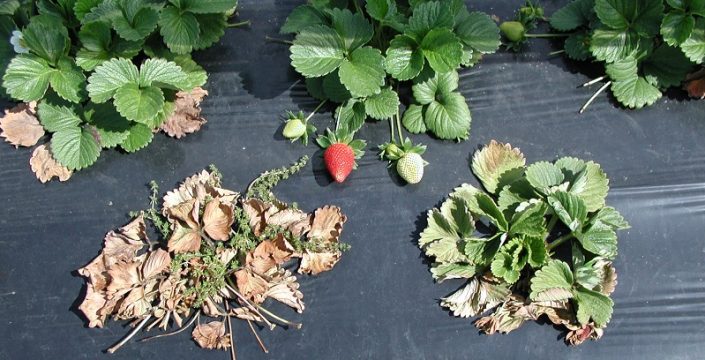
Brain decay (red root)
Disease Agent:Phytophtora fragariae
At flowering time, young leaves will be green-blue and older leaves will be yellow, orange or red. Infected roots have fewer minor branches. The outer region of the root remains white, but if the longitudinal section is taken from the decayed root, the vascular part is seen as red-to-brown stripe. Contamination occurs at 7 to 25 degrees.
Management:
- Proper drainage of soil
- Using healthy boots
- Chemical control before planting
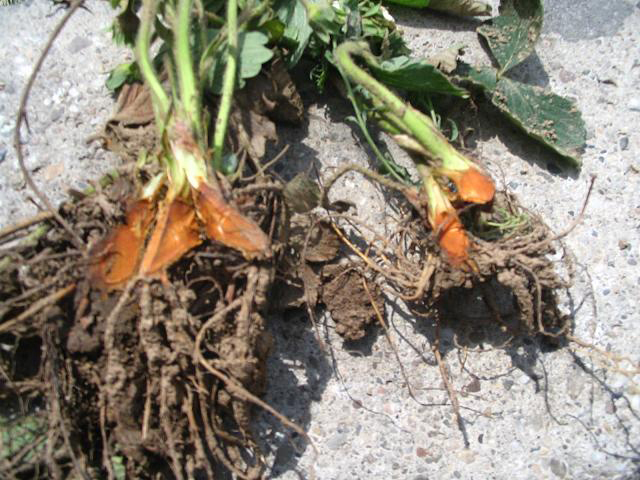
Rot of strawberry collar (southern blight)
Disease Agent:Sclerotium rolfsii
The cause of the disease is attacked at the place of contact with the soil surface and by infecting the roots and crowns, it causes sudden death of the plant. Dark brown spots are found on the stem or crown under the soil surface, which is hard to detect. The fungus remains the residues of the product.
Management:
- Sanitary measures such as removal of contaminated residues and bushes
- Avoiding cultivation in the country with a history of disease
- Disinfection of soil before planting plants
Bacterial diseases
Angled leaf stain
Disease Agent:Xanthomonas fragariae
Symptoms appear on different organs of the plant. In the leaves, small, watery spots are created on the lower surface of the leaves. The stains are usually dark green, but gradually turn red to brown and in some cases become necrotic.
The characteristic of the disease is the presence of transparent wounds against light and dark-colored wounds in the presence of light reflection. Temperatures of 20°C per day are suitable for bacterial activity.
Management:
- Using resistant authorities
- Removal of the residues of the alveodeh plant
b) Bacterial disease of strawberries
Bacterial wilting of strawberries
Disease Agent:Ralstonia solanacearum
The disease is caused by transplantation, the bacteria attacks a number of cells of the young transplant cells, in which case it prefers parenchymal tissues, so large holes caused by the lysine, which are filled with bacterial cells, are formed.
Management:
- Planting healthy bushes
- Suitable exposure, ventilation and drainage
- Use of fertilizer only during planting
- Observing the proper planting distance
c) Viral diseases
SMOV Strawberry Pisk Virus
The symptoms of the disease are the clarity of the veins, the presence of no specific boundaries and the dwarfism of the plant.Babala going to the ambient temperature, the symptoms of the disease decrease.The virus spreads throughout the plant after the cause of the problems, mesophilics, epidermis, evand-abkesh and cytoplasm. This virus can be transmitted through mechanical and transplantation, but the ability to transmit babzarotmas of al-Wasalm plant has not been reported.
Management:
- Using healthy boots
- Resistant cultivars
Tape Vein Virus (SVBV)
Symptoms in the primary leaves are formed as chlorotic strips in the main veins and in the leaf surface. While the contamination is mild, the veins turn translucent to yellow. It carries the strawberry aphid virus, which can be transmitted for up to eight hours after the virus is sold.
Management:
- Use of healthy and improved essays
- Carrier aphid fighting is the most appropriate method of control.
- Nematode-induced diseases
Weberg Branch Nematodes
Cause of disease: A.ritzemabosi-Aphelenchoides faragariae
The dwarf's aludeh bushes are growing, the size of young leaves is smaller than usual, which you turn reddish. Deformity of sprouts and gell is a symptom of the disease cycle of about 15 days.
Management:
- Collecting and burning contaminated remains
- Use certified and healthy essays
- Use of heated tamarity with hot water
- Using resistant authorities
- Spraying baparation as spraying
Root knot nematodes
Disease Agent:Meloidogyne spp
This nematode is severely damaged and sometimes destroys the strawberry bush. The root nematode of the node causes more damage during dry air. This nematode has less damage in heavy losses. Female nematodes and their produced nematodes can be detected under the stereomicroscope on the surface of infected roots.
Management:
- Soil testing before planting
- Disinfection of greenhouse soil before production in case of dichotomy
- Using hydroponic culture system
- Use of resistant cultivars
- Removal and burning of severely polluted bushes
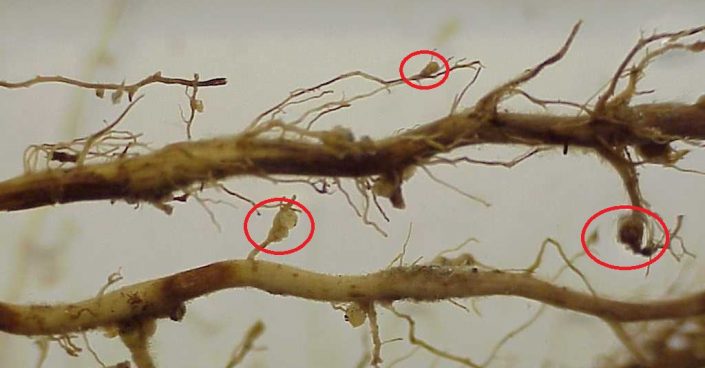
Nematodes causing root scarring
Cause of disease: P.pratensis and P.penetrans
General symptoms include dwarfism, jaundice, decreased growth and shrinkage of leaves. The obvious characteristic is the presence of necrotic spots or scars on the roots. The initial spots are small and brown, which, while destroying the root cortex layer, reduces its growth.
Management:
- Preventing stresses to plants and creating suitable conditions for growth
- Use hot water for 10-30 minutes for root treatment
Dagger nematodes
Disease Agent:Xiphinema spp
These nematodes are surface root parasites that penetrate deep into 4 to 5 cells of epidermis and cortex and cause reddish brown wounds on the roots. Feeding nematodes from the roots reduces the volume of the root system, which stops plant growth and reduces the production of stalks.
Symptoms include dwarfism, jaundice, decreased growth and shrinkage of leaves.
Management:
- Thermal treatment such as nematodes causing root wounds
- Strengthen plant growth
d) Physiological diseases
Fruit deformation is one of the common symptoms in greenhouses of strawberries, which is noted for reasons such as poor pollination, poor ventilation, high humidity and low light. Therefore, it is necessary to determine the need for high-consumption and low-consumption nutrients by conducting the experiment and based on the results, fertilization and strengthening of the plant.

